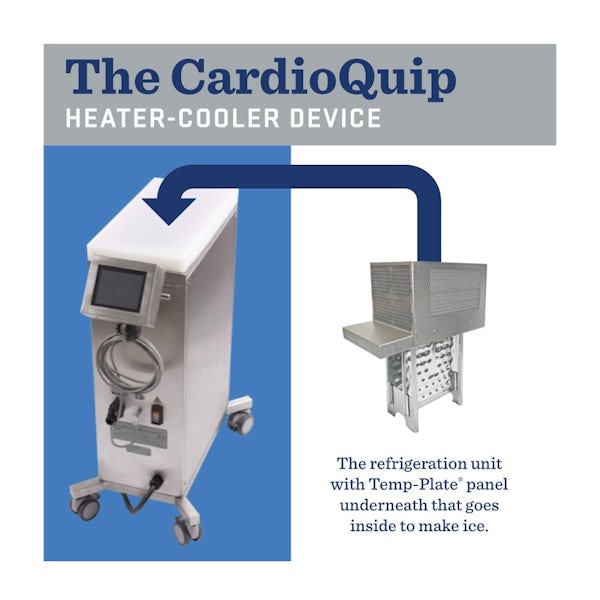Heat Exchange Technology for Open-Heart Surgery
- Share on Facebook
- Share on LinkedIn
- Share on Email
-
Copy Link
-
Share Link
- Heat Transfer
- April 24, 2020
- 5 Minute Read
- Share on Facebook
- Share on LinkedIn
- Share on Email
-
Copy Link
-
Share Link
Introduction
When a person has open-heart surgery, the heart is stopped for several hours so the surgeon can perform the procedure. To avoid heart tissue damage, the body is cooled from its normal 98.5 °F to a chilly 82.4-89.6 °F, thereby reducing the body's need for oxygen.
Making Ice in the Operating Room
Cooler-heater devices provide temperature-controlled water to the heart-lung machine while the patient is undergoing surgery to keep the body at that regulated temperature.
CardioQuip, a company out of Bryan, Texas, is revolutionizing how these cooler-heater machines work in the operating room and how they help the perfusionist - the medical personnel operating the cooler-heater device and the heart-lung machine.
Whereas other cooler-heater machines required operating room staff to go get ice to keep them working, CardioQuip dreamed of a system that would continually produce ice on its own, keeping the perfusionist focused on their work instead of worrying about whether there was enough ice to keep the patient's blood cold.
“When we first started designing the machines, we did an internet search to find ways to build ice. That’s what heat exchangers do,” said Doug Platt, Co-Owner of CardioQuip. “We found Paul Mueller Company.”
Small, Customizable Heat Exchange Panels for Portability
Doug's company came up with the CardioQuip MCH 1000. It provides that constant, temperature-controlled water that cools the blood that’s running through the patient’s body.
The unit has a large 9-gallon ice tank and can turn room-temperature water into an ice block in 5-6 hours. You can see this happening here in a timelapse. It does this with Paul Mueller Company heat exchange panels called Temp-Plate®.

“When CardioQuip first contacted us, we knew the unique need they had, which was heat exchange panels that were small and customizable,” said David Cummings with Paul Mueller Company. “That’s why our Temp-Plate® panels were perfect for this function.”
Adds Doug, “The Temp-Plate® panels allow us to have much more mobility. They are light, and they work. It’s allowed our MCH1000 to be portable and controllable with the touch of a button. Our system provides refrigeration while plugged into the wall because of the heat exchange technology, and the stainless steel panels are clean and light, which means less risk, ease of use, and consistency."
Innovating Success and Helping People
CardioQuip is starting to see the benefits of this innovative use case. More and more healthcare facilities are coming to them for their cooler-heater technology. Doug says CardioQuip continues to work with perfusionists to ensure that the technology they are creating improves the experience for medical personnel and patients.
More from Mueller Academy
- Introducing Our New Membrane-Based Water for Injection (WFI) Skids
- Manway Gasket Installation & Bushing Adjustment
- How to Decide Between a Horizontal & Vertical Milk Tank
- MES & PSG Feedwater Quality Requirements
- On-Site Tank Fabrication Under Deadline
- Finding the Right Finish: Understanding Polishing
- Increase the Capacity of Your Clean Utility Equipment
- Balancing a Mueller Multiple Effect Still (MES)
- The Different Types of Steam in Industrial Steam Generation